check engine RENAULT TWINGO 2012 2.G Owners Manual
[x] Cancel search | Manufacturer: RENAULT, Model Year: 2012, Model line: TWINGO, Model: RENAULT TWINGO 2012 2.GPages: 220, PDF Size: 6.73 MB
Page 22 of 220
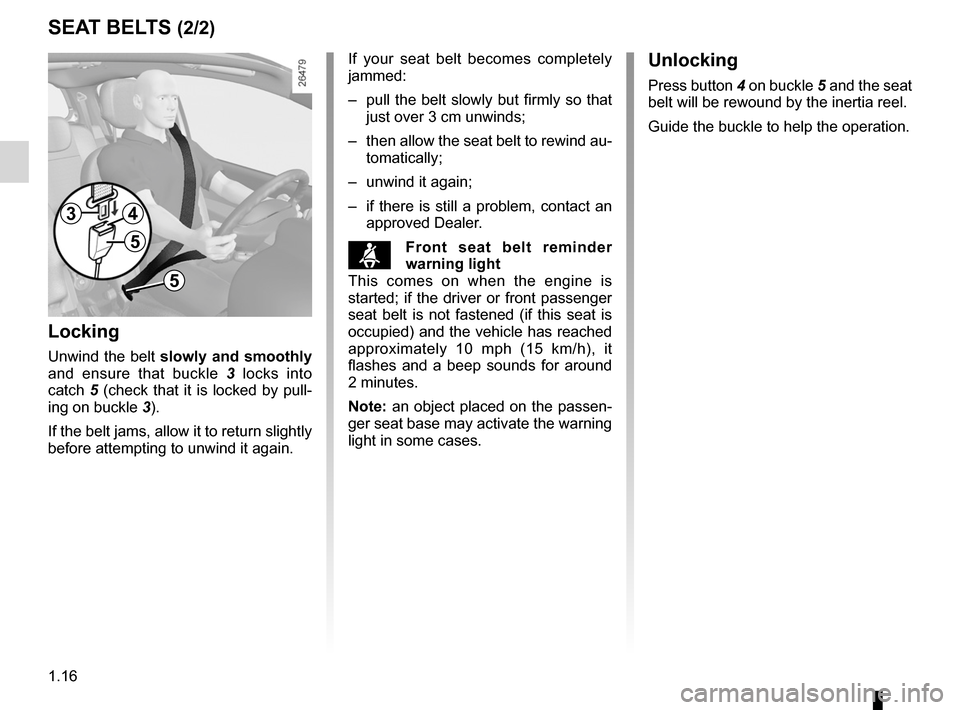
1.16
ENG_UD30822_6
Ceintures de sécurité (X44 - Renault)
ENG_NU_952-4_X44_Renault_1
sEAT BELTs (2/2)
Locking
Unwind the belt slowly and smoothly
and ensure that buckle 3 locks into
catch 5 (check that it is locked by pull -
ing on buckle 3).
If the belt jams, allow it to return slightly
before attempting to unwind it again. If your seat belt becomes completely
jammed:
–
pull the belt slowly but firmly so that
just over 3 cm unwinds;
– then allow the seat belt to rewind au-
tomatically;
– unwind it again;
– if there is still a problem, contact an
approved Dealer.
ßFront seat belt reminder
warning light
This comes on when the engine is
started; if the driver or front passenger
seat belt is not fastened (if this seat is
occupied) and the vehicle has reached
approximately 10 mph (15 km/h), it
flashes and a beep sounds for around
2 minutes.
Note: an object placed on the passen-
ger seat base may activate the warning
light in some cases.
34
5
5
Unlocking
Press button 4 on buckle 5 and the seat
belt will be rewound by the inertia reel.
Guide the buckle to help the operation.
Page 32 of 220
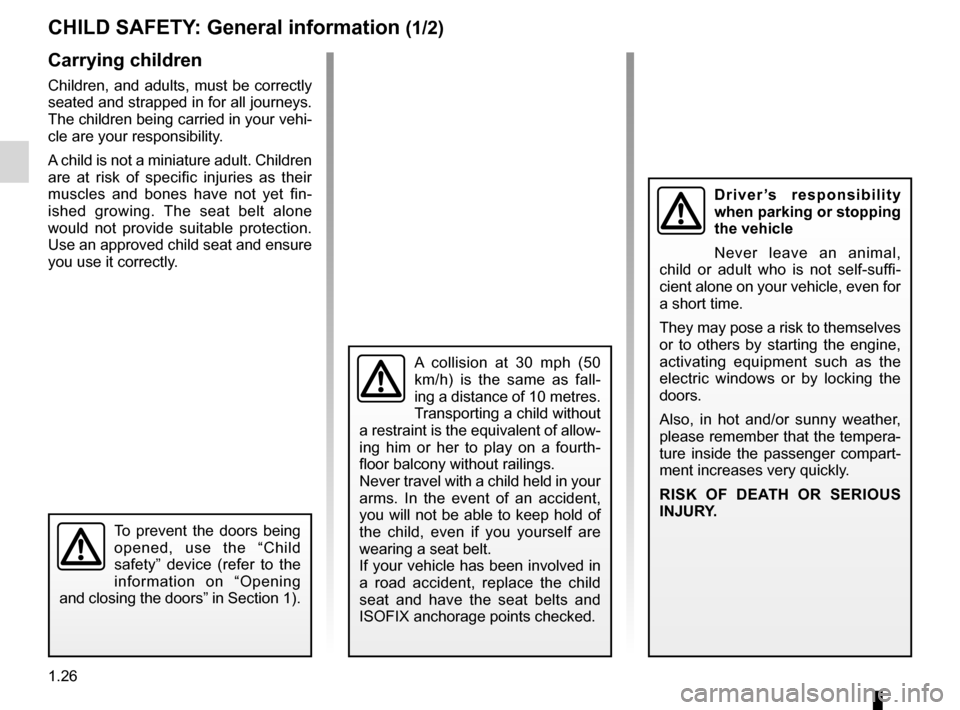
child safety............................................ (up to the end of the DU)
child restraint/seat ................................ (up to the end of the DU)
child restraint/seat ................................ (up to the end of the DU)
child restraint/seat ................................ (up to the end of the DU)
child seats ............................................. (up to the end of the DU)
transporting children ............................. (up to the end of the DU)
children ................................................. (up to the end of the DU)
1.26
ENG_UD20118_2
Sécurité enfants : généralités (X44 - Renault)
ENG_NU_952-4_X44_Renault_1
Jaune NoirNoir texte
Carrying children
Children, and adults, must be correctly
seated and strapped in for all journeys.
The children being carried in your vehi-
cle are your responsibility.
A child is not a miniature adult. Children
are at risk of specific injuries as their
muscles and bones have not yet fin -
ished growing. The seat belt alone
would not provide suitable protection.
Use an approved child seat and ensure
you use it correctly.
Child safety: General information
ChILD sAFETY : General information (1/2)
To prevent the doors being
opened, use the “Child
safety” device (refer to the
information on “Opening
and closing the doors” in Section 1).
A collision at 30 mph (50
km/h) is the same as fall -
ing a distance of 10 metres.
Transporting a child without
a restraint is the equivalent of allow-
ing him or her to play on a fourth -
floor balcony without railings.
Never travel with a child held in your
arms. In the event of an accident,
you will not be able to keep hold of
the child, even if you yourself are
wearing a seat belt.
If your vehicle has been involved in
a road accident, replace the child
seat and have the seat belts and
ISOFIX anchorage points checked.
D r i v e r ’s r e s p o n s i b i l i t y
when parking or stopping
the vehicle
Never leave an animal,
child or adult who is not self-suffi -
cient alone on your vehicle, even for
a short time.
They may pose a risk to themselves
or to others by starting the engine,
activating equipment such as the
electric windows or by locking the
doors.
Also, in hot and/or sunny weather,
please remember that the tempera-
ture inside the passenger compart-
ment increases very quickly.
RI sK OF DEAT h OR sERIOU s
INJURY.
Page 51 of 220
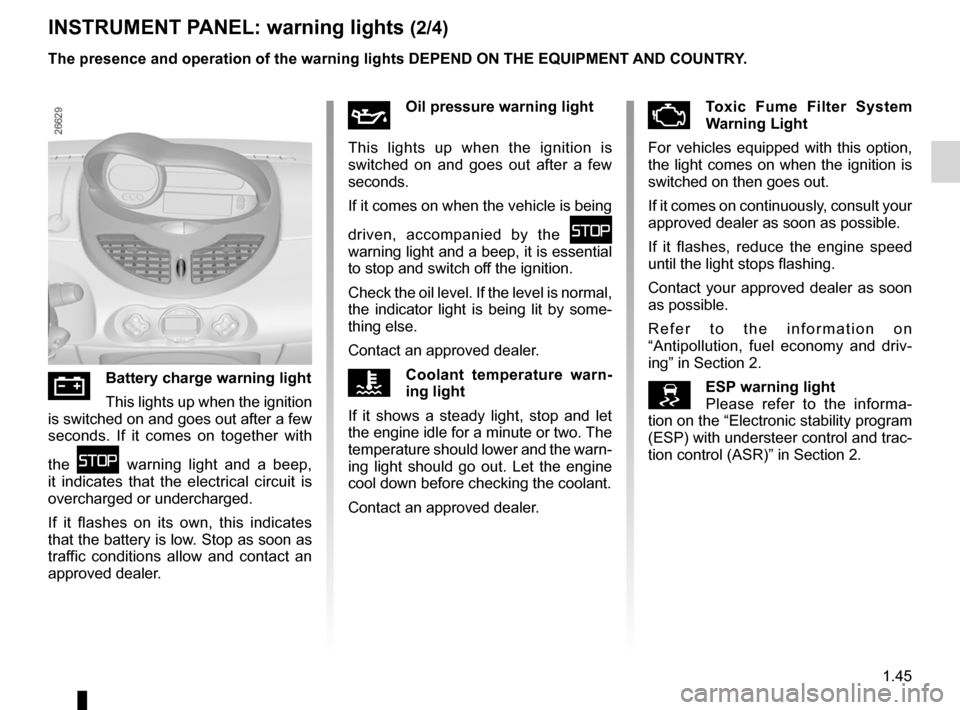
JauneNoirNoir texte
1.45
ENG_UD30823_8
Tableau de bord : témoins lumineux (X44 - Renault)
ENG_NU_952-4_X44_Renault_1
ÄToxic Fume Filter system
Warning Light
For vehicles equipped with this option,
the light comes on when the ignition is
switched on then goes out.
If it comes on continuously, consult your
approved dealer as soon as possible.
If it flashes, reduce the engine speed
until the light stops flashing.
Contact your approved dealer as soon
as possible.
R e f e r t o t h e i n f o r m a t i o n o n
“Antipollution, fuel economy and driv -
ing” in Section 2.
Esp warning light
Please refer to the informa -
tion on the “Electronic stability program
(ESP) with understeer control and trac-
tion control (ASR)” in Section 2.
INsTRUMENT p ANEL: warning lights (2/4)
ÚBattery charge warning light
This lights up when the ignition
is switched on and goes out after a few
seconds. If it comes on together with
the
û warning light and a beep,
it indicates that the electrical circuit is
overcharged or undercharged.
If it flashes on its own, this indicates
that the battery is low. Stop as soon as
traffic conditions allow and contact an
approved dealer.
ÀOil pressure warning light
This lights up when the ignition is
switched on and goes out after a few
seconds.
If it comes on when the vehicle is being
driven, accompanied by the
û
warning light and a beep, it is essential
to stop and switch off the ignition.
Check the oil level. If the level is normal,
the indicator light is being lit by some-
thing else.
Contact an approved dealer.
ÔCoolant temperature warn -
ing light
If it shows a steady light, stop and let
the engine idle for a minute or two. The
temperature should lower and the warn-
ing light should go out. Let the engine
cool down before checking the coolant.
Contact an approved dealer.
The presence and operation of the warning lights DEpEND ON ThE EQUIpMENT AND COUNTRY.
Page 70 of 220
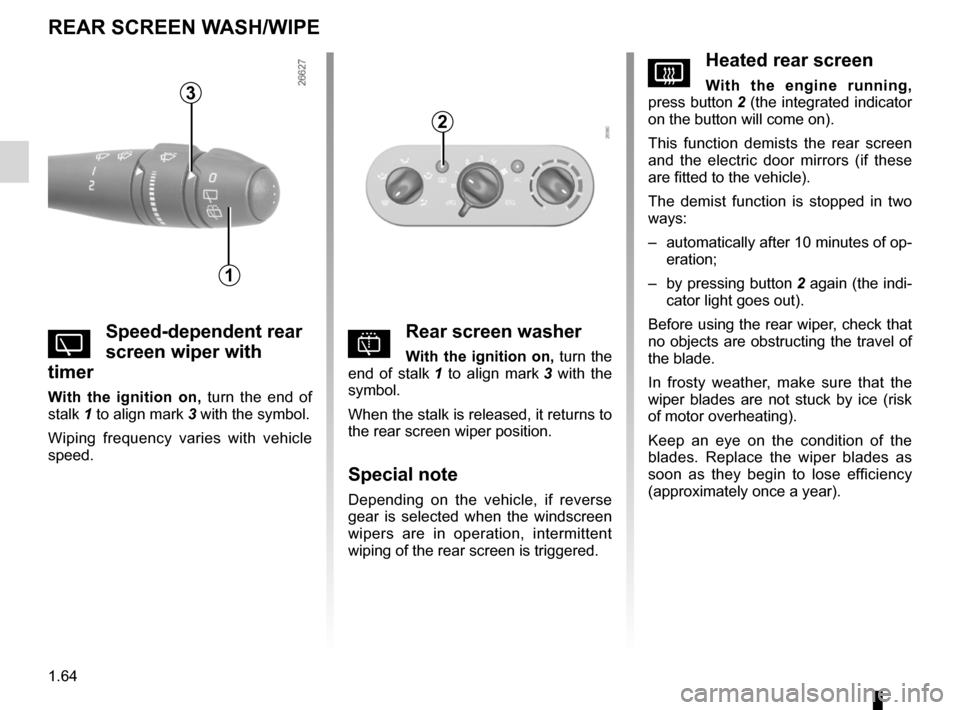
rear screen de-icing/demisting .............................. (current page)
windscreen washer ................................................ (current page)
wipers .................................................................... (current page)
1.64
ENG_UD24376_5
Essuie-vitre / Lave-vitre arrière / Dégivrage (X44 - Renault)
ENG_NU_952-4_X44_Renault_1
REAR sCREEN WAsh/WIpE
Vheated rear screen
With the engine running,
press button 2 (the integrated indicator
on the button will come on).
This function demists the rear screen
and the electric door mirrors (if these
are fitted to the vehicle).
The demist function is stopped in two
ways:
– automatically after 10 minutes of op-
eration;
– by pressing button 2 again (the indi -
cator light goes out).
Before using the rear wiper, check that
no objects are obstructing the travel of
the blade.
In frosty weather, make sure that the
wiper blades are not stuck by ice (risk
of motor overheating).
Keep an eye on the condition of the
blades. Replace the wiper blades as
soon as they begin to lose efficiency
(approximately once a year).
Yspeed-dependent rear
screen wiper with
timer
With the ignition on, turn the end of
stalk 1 to align mark 3 with the symbol.
Wiping frequency varies with vehicle
speed.
pRear screen washer
With the ignition on, turn the
end of stalk 1 to align mark 3 with the
symbol.
When the stalk is released, it returns to
the rear screen wiper position.
special note
Depending on the vehicle, if reverse
gear is selected when the windscreen
wipers are in operation, intermittent
wiping of the rear screen is triggered.
33
1
2
Page 71 of 220
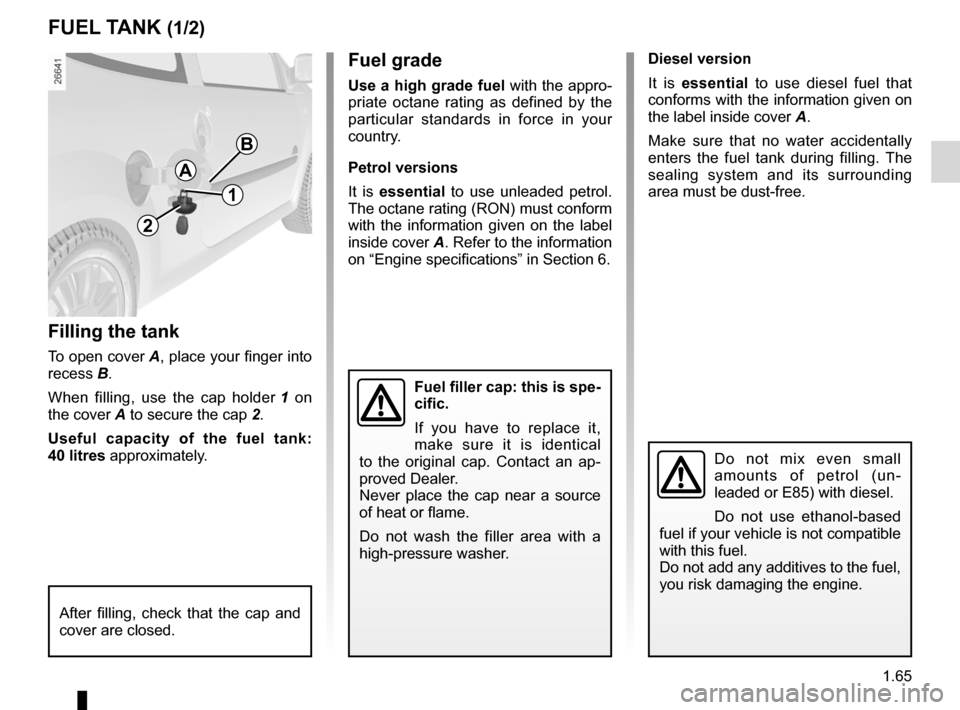
fuel tank ................................................ (up to the end of the DU)
fuel grade ............................................................... (current page)
fuel tank capacity ................................................... (current page)
1.65
ENG_UD22502_6
Réservoir carburant (X44 - Renault)
ENG_NU_952-4_X44_Renault_1
Fuel tank
FUEL TANK (1/2)
Diesel version
It is essential to use diesel fuel that
conforms with the information given on
the label inside cover A.
Make sure that no water accidentally
enters the fuel tank during filling. The
sealing system and its surrounding
area must be dust-free.Fuel grade
Use a high grade fuel with the appro-
priate octane rating as defined by the
particular standards in force in your
country.
petrol versions
It is essential to use unleaded petrol.
The octane rating (RON) must conform
with the information given on the label
inside cover A. Refer to the information
on “Engine specifications” in Section 6.
Fuel filler cap: this is spe-
cific.
If you have to replace it,
make sure it is identical
to the original cap. Contact an ap -
proved Dealer.
Never place the cap near a source
of heat or flame.
Do not wash the filler area with a
high-pressure washer.
After filling, check that the cap and
cover are closed.
Do not mix even small
amounts of petrol (un -
leaded or E85) with diesel.
Do not use ethanol-based
fuel if your vehicle is not compatible
with this fuel.
Do not add any additives to the fuel,
you risk damaging the engine.
Filling the tank
To open cover A, place your finger into
recess B.
When filling, use the cap holder 1 on
the cover A to secure the cap 2.
Useful capacity of the fuel tank:
40 litres approximately.
1
2
A
B
Page 77 of 220
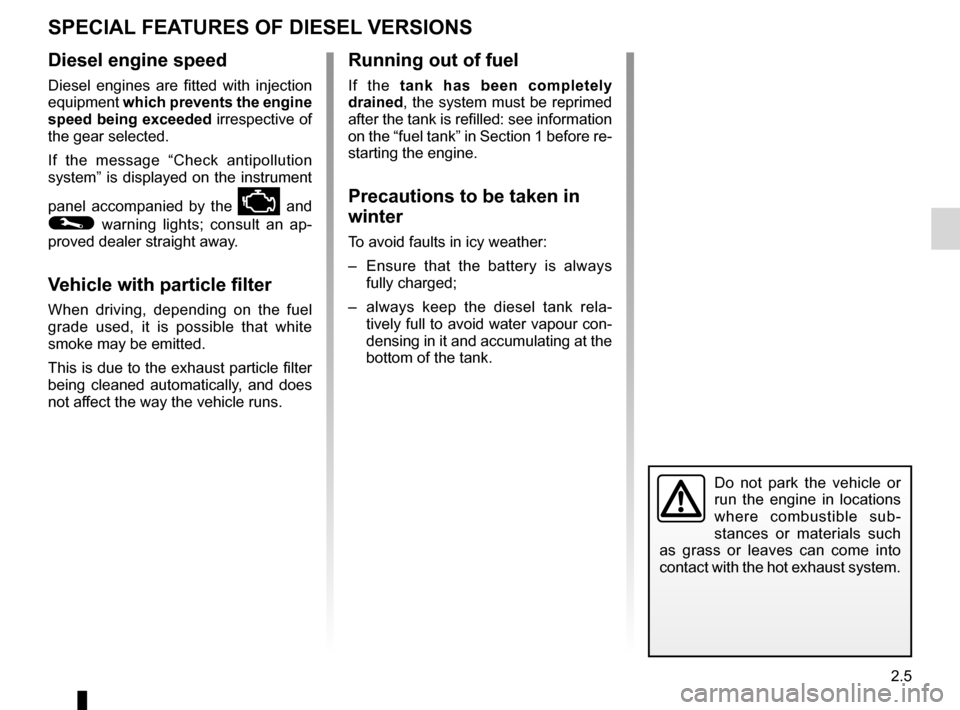
special features of diesel versions........(up to the end of the DU)
driving ................................................... (up to the end of the DU)
2.5
ENG_UD18926_2
Particularités versions diesel (X44 - Renault)
ENG_NU_952-4_X44_Renault_2
Special features of diesel versions
SPecIAl FeAtUReS oF DIeSel veRSIoNS
Diesel engine speed
Diesel engines are fitted with injection
equipment which prevents the engine
speed being exceeded irrespective of
the gear selected.
If the message “ Check antipollution
system” is displayed on the instrument
panel accompanied by the
Ä and
© warning lights; consult an ap -
proved dealer straight away.
v ehicle with particle filter
When driving, depending on the fuel
grade used, it is possible that white
smoke may be emitted.
This is due to the exhaust particle filter
being cleaned automatically, and does
not affect the way the vehicle runs.
Running out of fuel
If the tank has been completely
drained, the system must be reprimed
after the tank is refilled: see information
on the “fuel tank” in Section 1 before re-
starting the engine.
Precautions to be taken in
winter
To avoid faults in icy weather:
– Ensure that the battery is always
fully charged;
– always keep the diesel tank rela -
tively full to avoid water vapour con-
densing in it and accumulating at the
bottom of the tank.
Do not park the vehicle or
run the engine in locations
where combustible sub -
stances or materials such
as grass or leaves can come into
contact with the hot exhaust system.
Page 78 of 220
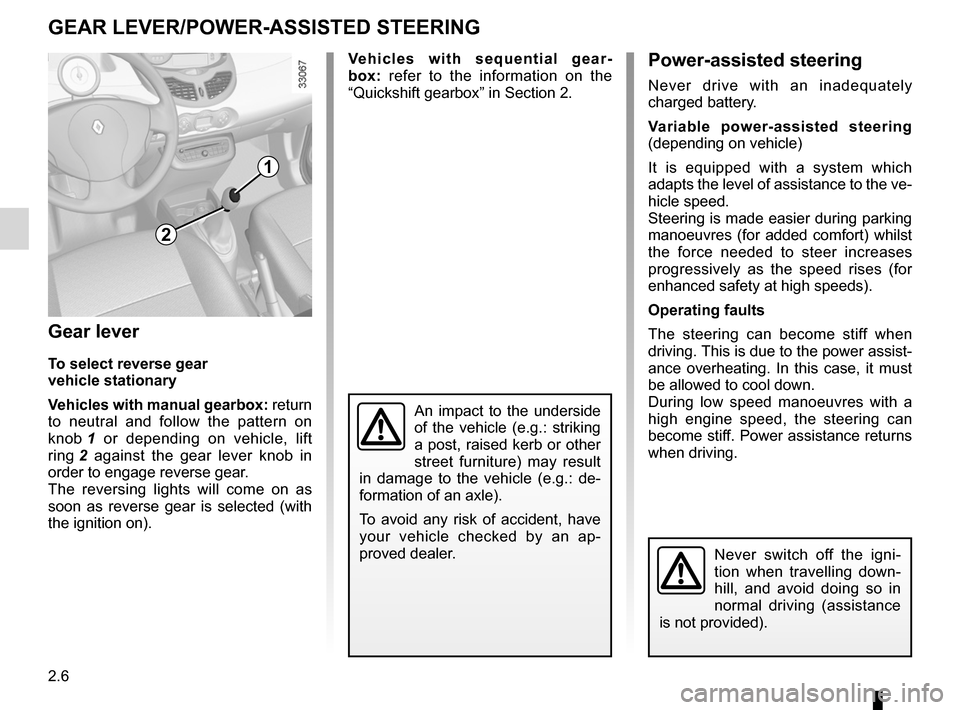
power-assisted steering........................(up to the end of the DU)
power-assisted steering ........................(up to the end of the DU)
gear lever .............................................. (up to the end of the DU)
reverse gear selecting .......................................... (up to the end of the DU)
changing gear ....................................... (up to the end of the DU)
2.6
ENG_UD24713_4
Levier de vitesses / Direction assistée (X44 - Renault)
ENG_NU_952-4_X44_Renault_2
Gear lever - Power-assisted steering
GeAR leveR/PoweR-ASSISteD SteeRING
Gear lever
t o select reverse gear
vehicle stationary
v ehicles with manual gearbox: return
to neutral and follow the pattern on
knob 1 or depending on vehicle, lift
ring 2 against the gear lever knob in
order to engage reverse gear.
The reversing lights will come on as
soon as reverse gear is selected (with
the ignition on).
2
1
Power-assisted steering
Never drive with an inadequately
charged battery.
v ariable power-assisted steering
(depending on vehicle)
It is equipped with a system which
adapts the level of assistance to the ve-
hicle speed.
Steering is made easier during parking
manoeuvres (for added comfort) whilst
the force needed to steer increases
progressively as the speed rises (for
enhanced safety at high speeds).
operating faults
The steering can become stiff when
driving. This is due to the power assist-
ance overheating. In this case, it must
be allowed to cool down.
During low speed manoeuvres with a
high engine speed, the steering can
become stiff. Power assistance returns
when driving.
Never switch off the igni -
tion when travelling down -
hill, and avoid doing so in
normal driving (assistance
is not provided).
v ehicles with sequential gear -
box: refer to the information on the
“Quickshift gearbox” in Section 2.
An impact to the underside
of the vehicle (e.g.: striking
a post, raised kerb or other
street furniture) may result
in damage to the vehicle (e.g.: de -
formation of an axle).
To avoid any risk of accident, have
your vehicle checked by an ap -
proved dealer.
Page 80 of 220
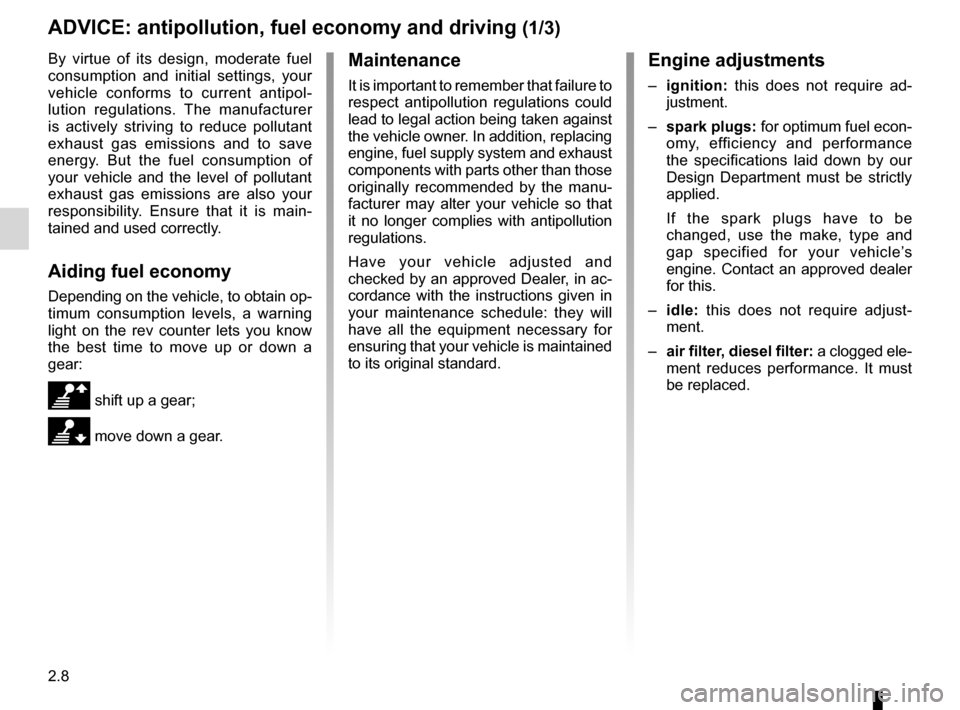
fueladvice on fuel economy .................. (up to the end of the DU)
practical advice ..................................... (up to the end of the DU)
fuel economy ........................................ (up to the end of the DU)
filter air filter ............................................................. (current page)
filter diesel filter ........................................................ (current page)
driving ................................................... (up to the end of the DU)
maintenance .......................................................... (current page)
antipollution advice ............................................. (up to the end of the DU)
2.8
ENG_UD27029_5
Conseils antipollution, économies de carburant, conduite (X44 - E33 - Renault)
ENG_NU_952-4_X44_Renault_2
Jaune NoirNoir texte
Advice on emission control and fuel economy
ADvIce: antipollution, fuel economy and driving (1/3)
By virtue of its design, moderate fuel
consumption and initial settings, your
vehicle conforms to current antipol-
lution regulations. The manufacturer
is actively striving to reduce pollutant
exhaust gas emissions and to save
energy. But the fuel consumption of
your vehicle and the level of pollutant
exhaust gas emissions are also your
responsibility. Ensure that it is main -
tained and used correctly.
Aiding fuel economy
Depending on the vehicle, to obtain op-
timum consumption levels, a warning
light on the rev counter lets you know
the best time to move up or down a
gear:
\ shift up a gear;
[ move down a gear.
Maintenance
It is important to remember that failure to
respect antipollution regulations could
lead to legal action being taken against
the vehicle owner. In addition, replacing
engine, fuel supply system and exhaust
components with parts other than those
originally recommended by the manu -
facturer may alter your vehicle so that
it no longer complies with antipollution
regulations.
Have your vehicle adjusted and
checked by an approved Dealer, in ac-
cordance with the instructions given in
your maintenance schedule: they will
have all the equipment necessary for
ensuring that your vehicle is maintained
to its original standard.
engine adjustments
– ignition: this does not require ad -
justment.
– spark plugs: for optimum fuel econ-
omy, efficiency and performance
the specifications laid down by our
Design Department must be strictly
applied.
If the spark plugs have to be
changed, use the make, type and
gap specified for your vehicle’s
engine. Contact an approved dealer
for this.
– idle: this does not require adjust -
ment.
– air filter, diesel filter: a clogged ele-
ment reduces performance. It must
be replaced.
Page 81 of 220
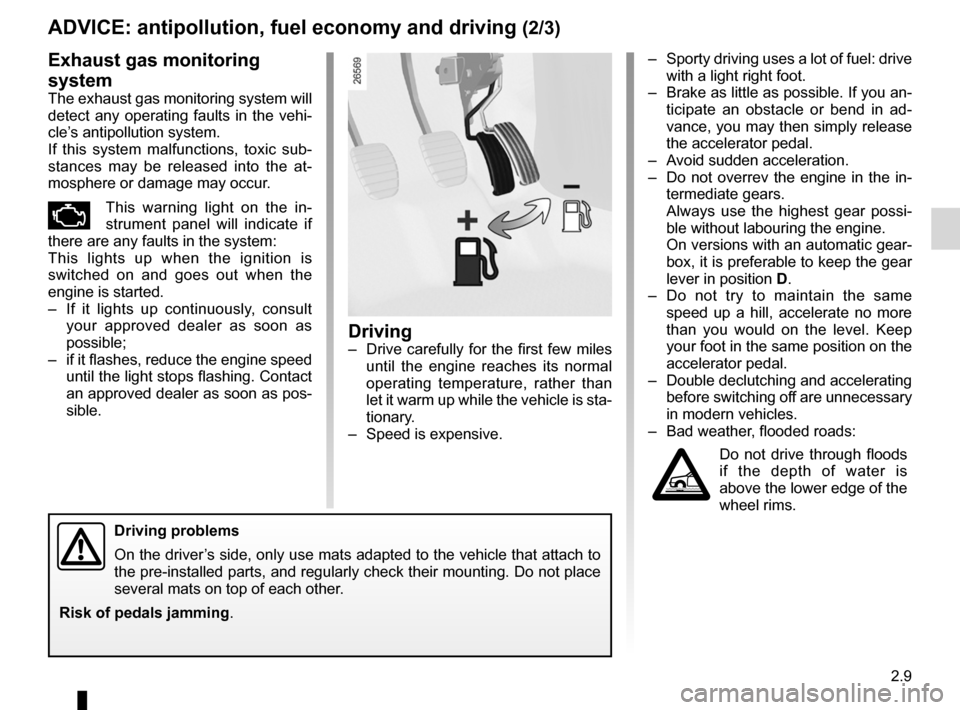
JauneNoirNoir texte
2.9
ENG_UD27029_5
Conseils antipollution, économies de carburant, conduite (X44 - E33 - Renault)
ENG_NU_952-4_X44_Renault_2
ADvIce: antipollution, fuel economy and driving (2/3)
Driving
– Drive carefully for the first few miles
until the engine reaches its normal
operating temperature, rather than
let it warm up while the vehicle is sta-
tionary.
– Speed is expensive.
exhaust gas monitoring
system
The exhaust gas monitoring system will
detect any operating faults in the vehi-
cle’s antipollution system.
If this system malfunctions, toxic sub -
stances may be released into the at -
mosphere or damage may occur.
ÄThis warning light on the in -
strument panel will indicate if
there are any faults in the system:
This lights up when the ignition is
switched on and goes out when the
engine is started.
– If it lights up continuously, consult
your approved dealer as soon as
possible;
– if it flashes, reduce the engine speed
until the light stops flashing. Contact
an approved dealer as soon as pos-
sible. –
Sporty driving uses a lot of fuel: drive
with a light right foot.
– Brake as little as possible. If you an-
ticipate an obstacle or bend in ad -
vance, you may then simply release
the accelerator pedal.
– Avoid sudden acceleration.
– Do not overrev the engine in the in-
termediate gears.
Always use the highest gear possi -
ble without labouring the engine.
On versions with an automatic gear-
box, it is preferable to keep the gear
lever in position D.
– Do not try to maintain the same
speed up a hill, accelerate no more
than you would on the level. Keep
your foot in the same position on the
accelerator pedal.
– Double declutching and accelerating
before switching off are unnecessary
in modern vehicles.
– Bad weather, flooded roads:
Do not drive through floods
if the depth of water is
above the lower edge of the
wheel rims.
Driving problems
On the driver’s side, only use mats adapted to the vehicle that attach to
the pre-installed parts, and regularly check their mounting. Do not place
several mats on top of each other.
Risk of pedals jamming .
Page 97 of 220
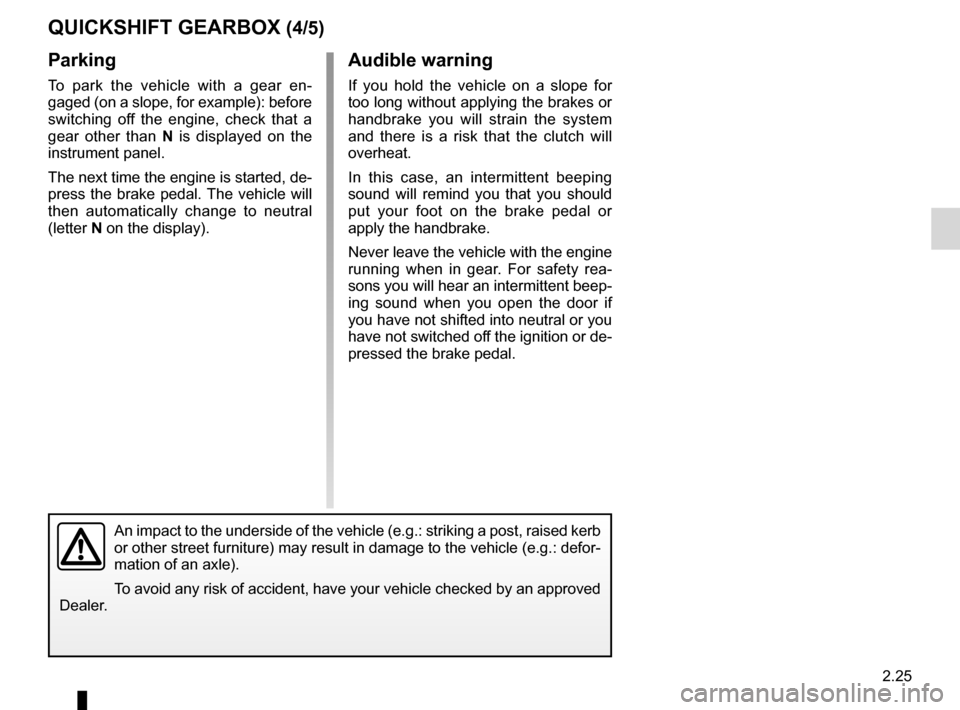
JauneNoirNoir texte
2.25
ENG_UD24716_6
Boîte de vitesses Quickshift (X44 - Renault)
ENG_NU_952-4_X44_Renault_2
QUIcKShIFt GeARBoX (4/5)
Parking
To park the vehicle with a gear en -
gaged (on a slope, for example): before
switching off the engine, check that a
gear other than N is displayed on the
instrument panel.
The next time the engine is started, de-
press the brake pedal. The vehicle will
then automatically change to neutral
(letter N on the display).
Audible warning
If you hold the vehicle on a slope for
too long without applying the brakes or
handbrake you will strain the system
and there is a risk that the clutch will
overheat.
In this case, an intermittent beeping
sound will remind you that you should
put your foot on the brake pedal or
apply the handbrake.
Never leave the vehicle with the engine
running when in gear. For safety rea -
sons you will hear an intermittent beep -
ing sound when you open the door if
you have not shifted into neutral or you
have not switched off the ignition or de-
pressed the brake pedal.
An impact to the underside of the vehicle (e.g.: striking a post, raised kerb
or other street furniture) may result in damage to the vehicle (e.g.: defor-
mation of an axle).
To avoid any risk of accident, have your vehicle checked by an approved
Dealer.